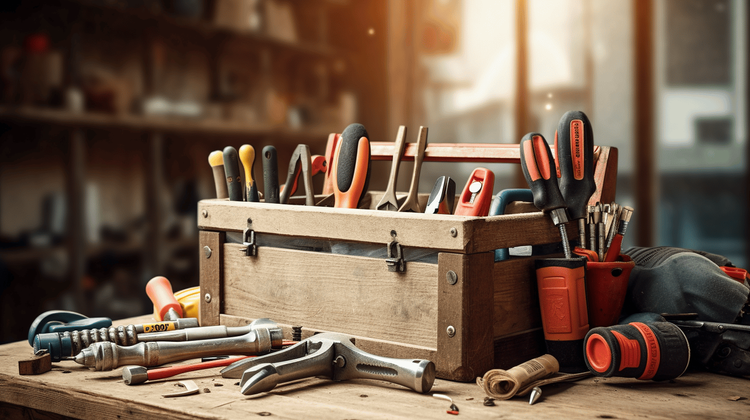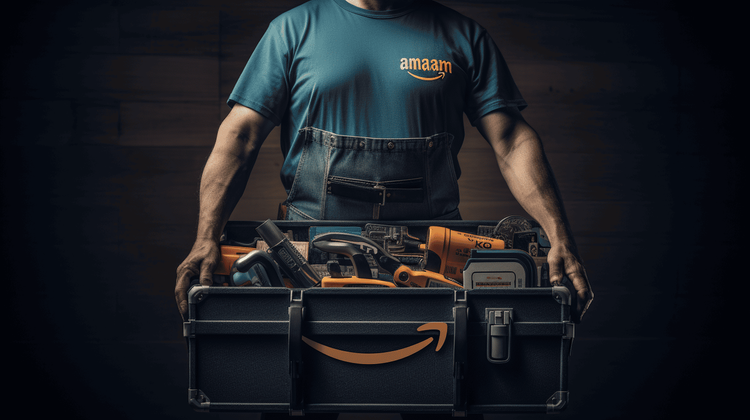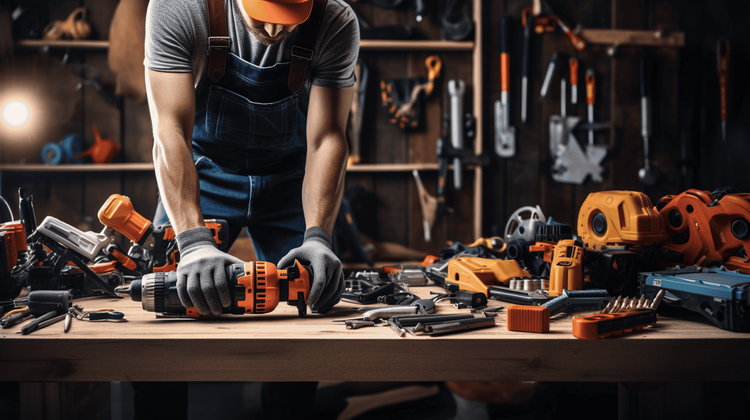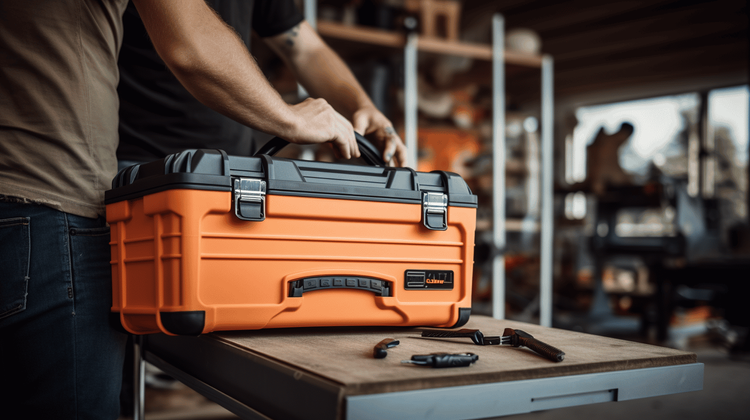Rule the DIY World: Comprehensive Guide to Budget Tools and Equipment
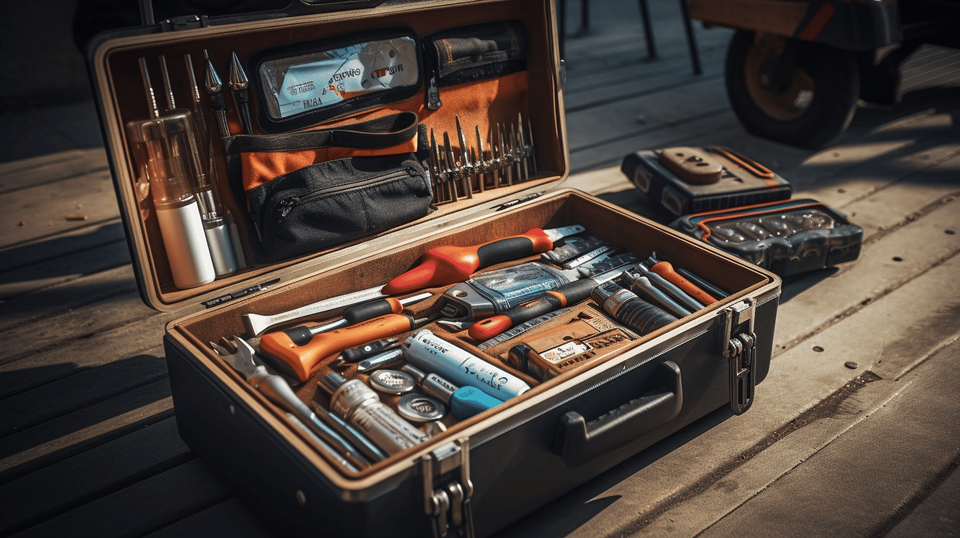
Dive into the wonderful world of doing it yourself! Whether you're starting a fresh DIY project, touching up some worn-out furniture, or just wanting to tackle tasks around the house, having the right tools can make all the difference. Armed with this comprehensive guide, you won't just be building shelves or repainting walls – you'll be creating new possibilities and experiences, while still taking it easy on your wallet.
Starting down the route of DIY requires good-quality, budget-friendly tools and equipment coupled with ample knowledge on their use, maintenance, and safety precautions. This guide will take you step by step, simplifying all the technical jargon you might encounter, and lightening your load with practical, pocket-sensible shopping and maintenance tips.
So if you're ready to turn your ideas into reality with a little to no impact on your budget, roll up your sleeves, and let’s get started! 🛠
Essential DIY Tools and Equipments
In the vast world of do-it-yourself (DIY), having the right tools and equipment at your disposal can make a world of difference. From a minor home repair to a major renovation project, the proper tools can ensure that the job gets done efficiently and safely. In this segment, let's explore the fundamental tools and equipment every DIY enthusiast must have in their arsenal.
Hand Tools
Hand tools are the backbone of any DIY project. They are typically small, manual, and versatile, giving you an intimate feel of the task at hand. Here’s what you should stock in your toolbox:
- Screwdrivers - A set of variously sized Phillips and flathead screwdrivers can assist you in almost any DIY scenario.
- Hammer - A standard claw hammer is essential for projects involving nails, hooks, or when something needs a little more force.
- Pliers - These are essential for gripping, bending, or cutting wires and fasteners.
- Tape Measure - An essential item to measure the materials before any cutting.
Power Tools
As you delve further into the world of DIY, power tools can make your work quicker, more efficient, and professional-looking. Here are a few you should consider:
- Electric Drill - This versatile tool can bore holes, insert screws, and, with the right attachments, can even stir paint or sand surfaces.
- Circular Saw - Ideal for making quick and precise cuts on wood.
- Jigsaw - Perfect for cutting curves and complex shapes.
Workshop Equipments
Depending on the type of DIY project you’re tackling, your workshop may require specialized equipment.
- Workbench - A sturdy work surface is paramount for many projects, from woodworking to electronics.
- Clamps - These tools can hold material in place, freeing your hands for other tasks.
- Vise - A vise can hold a piece steady, allowing you to work on it with both hands.
Safety Gear
"Safety first" is more than just a catchy phrase; it’s a rule to live by when you’re working with tools. Here are a few key pieces of safety gear:
- Safety Glasses - To protect your eyes from debris.
- Earplugs or Earmuffs - These will safeguard your hearing during loud operations.
- Gloves - These are imperative to protect your hands from sharp objects and hot surfaces.
From basics like screwdrivers and hammers to more sophisticated power tools, investing in the right tools and equipment can mean the difference between a laborious task and a rewarding DIY project. Remember, always prioritize safe operations over everything else. Happy DIY-ing!
Procuring Budget Tools
Whether you're a seasoned handyman, humble homeowner, or an aspiring DIY enthusiast, you will agree that procuring budget tools is a craft of its own. We've all been through the daunting experience of walking into a hardware store, inspecting countless tools with varying features and staggering price tags. This section of the article will unveil the secret dynamics of buying, maintaining, and deciding whether to rent or buy specific tools.
Shopping Tips for Quality and Affordability
Rather than rushing out to the nearest store to buy the first set of tools you find, it’s essential to come up with a strategy. If you're looking for quality at affordable prices, here are some tips to keep in mind:
- Understand your needs: Select tools that have features specific to your needs. No matter how eye-catching that ultra-modern laser level appears, if all you need is a basic spirit level, then there's no need to spend extra.
- Research before purchasing: Countless reviews are available online, offering a wealth of valuable information.
- Check out sales and offers: Many stores offer seasonal or end-of-year discounts that can provide considerable savings.
"Don't mistake cost for value when buying tools."
Maintaining Your Tools for Longevity
Let's say you've finally made the purchase. What comes next? Tools, like anything else, require maintenance to ensure they last. Some tips for maintaining your tools include:
- Clean your tools after use to prevent dirt buildup and rusting.
- Regularly inspect your tools for wear and tear, repairing or replacing parts as necessary.
- Always store your tools in a dry, secure location to protect against the elements.
Just like people say, "Take care of your tools, and they'll take care of you."
Renting vs Buying: Making the Right Choice
One important question to consider when procuring tools is whether to buy them or rent them. Here are few things to ponder:
- Frequency of use: If you plan to use the tool frequently, buying may be a cost-effective option in the long run.
- Storage: If you have limited space, renting might be the way to go!
- Cost: If the tool is expensive and you only need to use it once or twice, consider renting.
In the world of budget tools, knowledge is power. By following these simple strategies, you're sure to get more bang for your buck! Remember, your "toolbox" isn’t just what you carry around to fix things, it's also the wealth of knowledge you possess on navigating this tricky landscape.

Maximizing the Use of DIY Tools
Indeed, there's a certain charm in being able to accomplish tasks independently. No wonder the "Do It Yourself" or DIY trend has been gaining immense popularity. DIY enthusiasts often can't resist the allure of rolling up their sleeves and get working with their trusty tools. Today, we're going to delve into how you can maximize the use of these tools and explore three engaging subjects: mastering multi-use tools, tips on proper care and maintenance, and the do's and don'ts of DIY tool usage.🛠️
Mastering Multi-use Tools
Probably one of the most exciting aspects of DIY projects is the use of multi-use tools. These are the "superheroes" of toolboxes, donning more than one superpower. These handy fellows can perform various tasks, not just save you storage space, but could also be a lifesaver when working in compact areas, where typical tools might not be of much help. However, mastering them isn't always the easier route.
- Understand it: A major part of mastering multi-use tools begins with understanding these tools' multiple functionalities. Consider staying shoulder-to-shoulder with the latest updates in DIY tool tech.
- Practice: Rome wasn't built in a day, and your mastery over multi-use tools won't be either. Taking time to practice using these tools can drastically improve your skill level.
- Safety First: Never neglect safety, even though it seems convenient to use multi-use tools, improperly using them could lead to injuries. Always read the instruction manual and abide by the safety guidelines.
Proper Care and Maintenance
Just like any other investment, DIY tools also require regular maintenance and care to ensure longevity and optimum functionality. Besides, nothing possibly spells DIY enthusiast louder than a well-maintained toolkit. Here are a few tips:
- Cleanliness: After every use, make sure to clean your tools and store them in their designated places. Spring cleaning isn't just for your house; your tools need it too!
- Regularly inspect: If you notice any sign of wear and tear on your tools, it might be time to replace them.
- Lubricate: Yes, your tools need moisturizer too! Lubrication helps prevent rusting and keeps your tools in their prime condition.
Do's and Don'ts of DIY Tool usage
Lastly, but most importantly, you need to understand the do's and don'ts of using DIY tools.
DO's
- Do read and carefully follow tool instructions.
- Do use safety gear like gloves, goggles, and respiratory protection while working with tools.
- Do pay attention to what you're working on and avoid distractions.
DON'Ts
- Don't use power tools without proper training or supervision.
- Don't leave tools lying around, especially in the way of children.
- Don't ignore any signs of damage or wear on your tools.
Being a DIY enthusiast is not just about possessing the tools but being proficient in their use and maintaining them. Surely, the paths to successful DIY ventures are paved with learning, practice, and a dash of safety! Now, you're not just ready to maximize your tools; you're ready to conquer your DIY projects skillfully. 🧰
Tips for Organizing Your Tools
When it comes to successfully executing any project, an organized toolbox is your best ally. It keeps your workflow smooth, increases efficiency, and adds a professional touch to your workspace- whether it's a garage, a shed, or a kit you carry on-the-go. In this section, we'll delve into some practical tips to keep your tools organized systematically.
Storage Solutions
First things first, you need to consider your individual storage needs. What works best will largely depend on the nature and quantity of your tools. Here are a few interesting solutions that might be suitable for you:
- Tool Chests: These allow for easy accessibility, with tools laid out in a manner that's visible at a glance. Plus, they offer considerable space, making them ideal for larger tool collections.
- Pegboards: Highly customizable, pegboards give you the freedom to arrange your tools as you'd like. Tools stay within arm's reach, hung on hooks. They're perfect for smaller spaces! 🏠
- Coding Skills: If you've been budgeting for coding tutorials and have managed to learn programming languages such as Python or JavaScript, freelance coding could become a lucrative side gig. Always remember that code is poetry👨💻.
- Graphic Design: When you've invested in design software subscriptions and have refined your skills, consider offering your talent in freelance graphics design. With your creative eye👁️, create graphic content for businesses and individuals for a fee.
- Language Proficiency: Suppose you have a knack for languages and have paid for language classes. In that case, you can freelance as a translator or offer language tutoring services.️ Remember, language is the roadmap of culture 🌍.
- Handicrafts: These can be pieces of artwork, jewelry, or even home decor. Your crafts can appeal to people who love handmade items and appreciate the art behind it 🎨.
- Homemade Food: If culinary skills are your strength and you've previously spent money on cooking classes and utensils, why not try baking or cooking for profit? Your homemade jams or cookies can be a hit in the community 👩🍳.
- Gardening: If you've spent on gardening tools, you can sell home-grown organic vegetables or even potted plants. After all, to plant a garden is to believe in tomorrow 🌱.
- Craft Classes: Be it painting, knitting, or sculpture, you can start your classes right from your living room 🎭.
- Home Improvement Workshops: You could run tutorials on basic plumbing or carpentry. There’s something liberating about fixing things yourself 🔧.
- Cooking Classes: Transform your kitchen into a culinary school and teach enthusiasts your unique recipes 👨🍳.
- Always wear protective gear such as gloves, safety goggles, and hard hats when necessary, especially when dealing with potentially dangerous tools.
- Ensure that the workspace is well-lighted and clean to avoid tripping or other accidents caused by unseen obstacles.
- Unplug power tools when not in use to avoid accidental activation.
- Clean the injury lightly with cool water and soap.
- Use a sterile bandage or cloth to stop any bleeding.
- If the injury is severe, seek immediate medical help. Don’t move injured people unless it’s necessary to avoid further injury.
- Clean your tools after each use to remove dirt, grease, or rust.
- Regularly oil moving parts to ensure smooth operation.
- Store them in a dry, cool area to prevent rust and damage.
- What are the essential budget tools and equipment for DIY projects?The essential budget tools and equipment for DIY projects include a hammer, screwdrivers (flathead and Phillips), pliers, measuring tape, level, utility knife, power drill, and a set of wrenches.
- Where can I find budget tools and equipment for my DIY projects?Budget tools and equipment for DIY projects can be found at various places such as hardware stores, online marketplaces like Amazon or eBay, garage sales, or even borrowing from friends or family members.
- What factors should I consider when buying budget tools and equipment?When buying budget tools and equipment, consider factors such as quality, durability, versatility, user reviews, and warranties. It's important to strike a balance between affordability and functionality.
- Are budget tools and equipment as reliable as expensive ones?While budget tools and equipment may not have the same level of durability or advanced features as expensive ones, they can still be reliable for DIY projects. It's important to choose reputable brands and properly maintain and use the tools.
- Can I use budget tools and equipment for professional projects?Using budget tools and equipment for professional projects is generally not recommended. Professional projects require higher-quality and more durable tools that can withstand frequent and heavy use. Investing in reliable tools is crucial for the success and safety of professional projects.
Portabl
Turning Your Budget Tools into Moneymaker
In a world where financial independence reigns supreme, it is crucial to explore various avenues to generate income. Usually, the tools you have ignored in your budget could turn out to be your most significant moneymaker. With a bit of creativity and motivation, the skillset you already possess can be an excellent source of extra income. You can leverage your budget tools to freelance your skills, make DIY items for sale, or even teach DIY classes. Thumbs up 👍 to a more independent future. Let's delve right into how this can be achieved.
Freelancing Your Skills
It's time to take a good look at your skills with a fresh perspective. Your technical skills or unique hobbies can help you provide services on the freelance market. Here are some examples:
DIY Items for Sale
If you're a hands-on kind of person, why not consider converting those budget tools into money? If your tools are gathering dust, it's time to pull them out and craft some wonderful DIY items for sale.
Teaching DIY Classes
If you are adept at any skill, there is a high probability that someone else wants to learn it from you. Your once-upon-a-time budgeted tools are your instruments to teach and earn simultaneously. The desire to learn DIY skills is on the rise, and you could be the one helping others while making money out of it.In summation, potential earnings can always be found in unexpected places. Your once budgeted items can turn into a steady source of income with a dash of creativity and the right approach. Remember, the future depends on what you do today 🚀.
Safety Precautions and Maintenance
When it comes to working in any field that involves tools or machinery, safety should always be your number one priority. 🚧 From construction sites to home DIY projects, the knowledge of proper safety measures, immediate first-aid guidelines, and comprehensive care for your tools can make all the difference. These practices not only protect you from potential harm but also ensure that your tools remain in the best possible condition for continuous optimal use.
Safety Measures
Thinking of picking up that power drill or chainsaw without safety gear? Think again! 🧐 A significant part of maintaining workplace safety lies in adhering to precautionary measures. Here are some pivotal tips:Remember, safety should never be compromised under any circumstance.
First Aid Guidelines
Accidents are unforeseen, and though we try our best to prevent them, it is equally important to know how to react when they do occur. Immediate and correct first aid response can dramatically mitigate injury severity. Here are some universally applicable first aid guidelines:Do take note that these are general guidelines. Comprehensive first-aid training is highly recommended to handle emergencies more effectively.
Proper Cleaning and Storage of Tools
Like any other investment, your tools need routine care and maintenance to function optimally and last long. Preserving your tools goes beyond storing them in a toolbox. 🧰 Here’s a simple yet effective routine to maintain your tools:One must remember, a tool is as efficient as the hand that wields it. Taking care of your tools can prevent unnecessary mishaps and maintain their performance.Safety precautions and proper maintenance are cornerstones for any successful project, be it at home or at a construction site. The adage "A stitch in time saves nine" is very apt in the context of safety and maintenance. By following these tips and training appropriately, you can make your workspace safer, more efficient, and set the stage for excellence. After all, safety is not just about meeting regulations; it’s about ensuring everyone goes home safely at the end of the day. 🏡🔧🌈
Conclusion
Armed with this holistic guide, we now know that there is a world of possibility with the right DIY tools, and they don't have to squeeze your wallet either! You can create, freelance, sell, and even teach with your newfound expertise. But remember, the key to making the most out of your tools is how you store and care for them.And speaking about key storage, perhaps you might find the Ultra Handy Bit Holder Keychain beneficial in your DIY journey. Designed for the enthusiastic DIYer and professionals alike, this compact essential keeps your drill bits within hands reach, saving you from the hassle of misplacing them during crucial projects.Just as we've demystified the world of DIY for you, Ultra Handy's vision is to help customers like you succeed in life and your work. From tools to supplements, our Amazon store is stocked with everything you need to stay on top of your game.With all these budget tools, tips, and Ultra Handy backing your DIY journey, a world of innovation is right at your fingertips. So, kick start your projects and carve your path in the DIY world. Happy DIY-ing! 🎉
